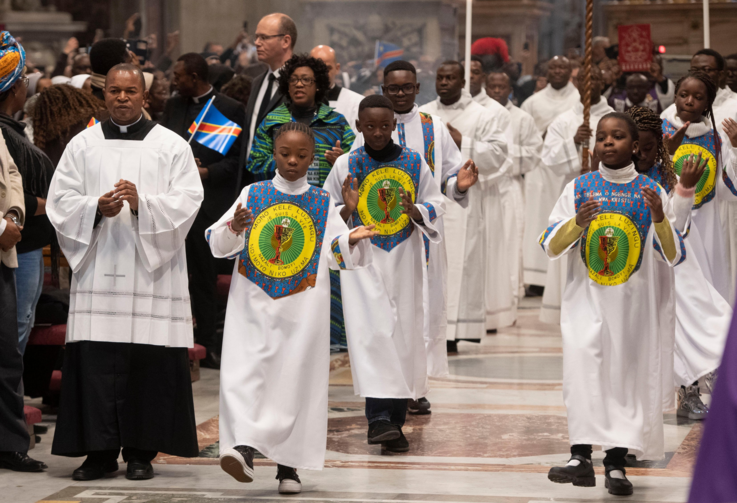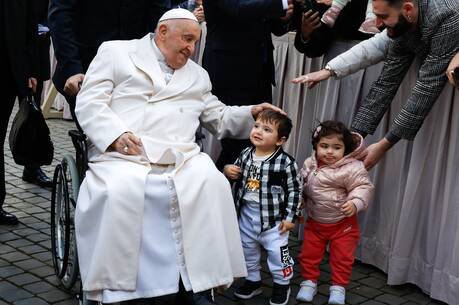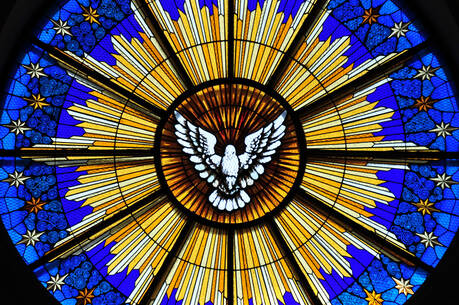Mass at the Vatican on the First Sunday of Advent last year, Dec. 1, 2019, was a much different affair than usual. The boys and men of the Sistine Chapel Choir had the day off. In their place, some 30 women dressed in brightly-patterned dresses were ushered in—alongside only a handful of men. Not a note was heard on the pipe organ. The sound of marimbas, electric guitars, hand shakers and African and electronic drums echoed throughout St. Peter’s Basilica.
The music was not all that was different from the usual Vatican liturgy. The penitential rite came after the homily and was immediately followed by the sign of peace, showing that the people’s reconciliation with God leads them to make peace with one another.
As unfamiliar as this celebration might appear to many Catholics, there was actually nothing extraordinary about this Mass. It is simply that on this Sunday, Pope Francis chose to celebrate the Mass using the Zaire rite of the Roman Missal to mark the 25th anniversary of the Congolese community in Rome.
Pope Francis has again brought attention to the Zaire rite, suggesting that it is a model for similarly inculturated liturgies in other parts of the Catholic world.
Now, a year later, Pope Francis has again brought attention to the rite, suggesting that it is a model for similarly inculturated liturgies in other parts of the Catholic world.
“The experience of the Congolese rite of celebrating the Mass,” the pope said, in a video message from the Vatican on Dec. 1, “can serve as an example and model for other cultures.”
The video was produced to coincide with the launch of a new book about the Zaire rite, Pope Francis and the Roman Missal for the Dioceses of Zaire, from the Vatican Publishing House. The book is edited by Sister Rita Mboshu Kongo, a member of the congregation of the Daughters of Mary, the Most Holy, Co-Redemptrix, who teaches theology and formation for consecrated life at the Pontifical Urbaniana University in Rome.
“This rite is the proof that each people can pray to the God of Jesus Christ from its cultural riches and expressions without altering the unity of the Catholic faith,” Sister Kongo told America.
“This rite is the proof that each people can pray to the God of Jesus Christ from its cultural riches and expressions without altering the unity of the Catholic faith.”
The launch of the book signified “a very important event for the church in Africa,” Pope Francis said. He highlighted the subtitle of the book, “A promising rite for other cultures,” affirming that it is “the fundamental reason behind this publication,” he said. “A book that is the testimony of a celebration lived with faith and joy.”
But what is the Zaire rite, and why is Pope Francis talking about it now, 30 years after it was officially approved for use?
What is the Zaire rite?
In 1988, the Congregation for Divine Worship and the Discipline of the Sacraments approved the “Roman Missal for the Dioceses of Zaire.” Today, it is the only inculturated rite approved for use by the Catholic Church. Although work on the Zaire rite is said to have begun in 1961, the project took root only after the Second Vatican Council.
In its document on the liturgy, “Sacrosanctum Concilium,”Vatican II gave the bishops and the people of then-Zaire—known today as the Democratic Republic of the Congo—the confidence and theological backing they needed to make the rite a reality. “One of the main contributions of Vatican II,” the pope said in his video message, “was precisely to propose norms for adaptation to the character and traditions of various peoples.”
In 1969, the bishops of Zaire established a research committee to piece together what a rite that was indigenous and faithful to the experience of the Zairean people might look like. The fruit of that research was presented to the Vatican office responsible for the liturgy and sacraments and in 1973; the Zaire rite was then cleared for experimental use. Fifteen years and two popes later, in April 1988, the rite was officially recognized and approved by John Paul II.
Vatican II gave the bishops and the people of then-Zaire the confidence and theological backing they needed to make the rite a reality.
“The Congolese rite of the Eucharistic celebration,” said Pope Francis, “emphasizes the different languages, colors and body movements which interact, by leveraging all the dimensions of the personality of the faithful, always taking into account the specific values of each people.”
Nathan Chase, an assistant professor of theology at the Aquinas Institute of Theology in St. Louis, Mo., explains the three models that shaped the creation of this unique African rite in his article, “A History and Analysis of the Missel Romain pour Les Dioceses du Zaïre.”
For the creators of the rite it was necessary to incorporate not only the more familiar rite contained in the Roman Missal, Mr. Chase explains, but also to introduce important elements of the lived experience of Congolese society, like the tribal leader and the rituals and practices common to community gatherings. Thus, the Congolese celebration of the Mass incorporated not only structural changes to the order of Mass but also, said Pope Francis, “the personality of the faithful,” as individual people and as a community at worship.
A notable difference of the Congolese liturgy, for example, is the inclusion of an announcer. A role open to women and men, the announcer mediates between the priest and the people. The Zaire rite instructs that the announcer “introduces the readings with a brief admonition” and “intervenes in the dialogue before the Eucharistic Prayer.” Before the Gospel reading, there is also a procession to enthrone the book of the Gospels.
The Congolese celebration of the Mass incorporated “the personality of the faithful,” as individual people and as a community at worship.
Another change to the usual order of Mass comes just after the homily. Whereas in the ordinary Roman rite the penitential rite comes at the beginning of the Mass, in the Congolese rite the people ask for God’s mercy only after they have heard God’s Word. “We cannot ask for forgiveness until we have heard the word of God,” said Cardinal Laurent Monsengwo, the Archbishop of Kinshasa from 2007 to 2018, when he explained the rationale behind the penitential rite at the Third African National Eucharistic Congress in Washington in August 2016. “We have to know the teaching of the church first.”
Immediately after the penitential rite, the people are invited to exchange a sign of peace. The change is driven by a desire to be faithful to the teachings of Jesus in the Bible, where the people are encouraged to make peace with one another before sacrificing their gifts at the altar (Mt 5:23-24.)
At the preparation of the gifts, the rite allows for another variation. During the pope’s Advent Mass at the Vatican, women and children processed in front of the sanctuary carrying fruit baskets and other items. “Coming to the Church everyone brings their offering,” the Congolese ritual instructs. According to the rite, the people also have a speaking part at this time. When handing the bread and wine to the priest for consecration, they are instructed to say: “O priest of God here are our gifts, receive them. They manifest our spirit of solidarity and sharing, and they show that we love one another as the Lord loves us.”
The congregation also has spoken responses during the Eucharistic prayer itself and throughout the Mass. It is customary for the readers to approach the priest for permission before proclaiming the reading, stand for the Gospel acclamation and to sit for the proclamation of the Gospel.
A more controversial aspect of the Congolese celebration comes at the beginning of the Mass, with the invocation of the saints and ancestors.
A more controversial aspect of the Congolese celebration comes at the beginning of the Mass, with the invocation of the saints and ancestors. “And you,” worshippers say, “our righteous ancestors be with us.” Some people say the practice of invoking the ancestors—who are not all Christian—during the Catholic liturgy admits of syncretism.
Quoting Chris Nwaka Egbulem, a liturgical scholar, to defend the role of ancestors for Africans, Mr. Chase writes: “Ancestors are the wise, brave and old parents (men and women) who in their time of human existence have brought honor to their families and descendants.” In this way, “the ancestors that Africans celebrate are those that have modeled a life worth emulating,” Mr. Chase continues. “Because the invocation of the ancestors is so important, the bishops of Zaire thought it must be included in a truly Zairean liturgy.”
Why is Pope Francis talking about the Zaire rite now and what does this have to do with the Pan-Amazon region?
The impetus for the Zaire rite came from Vatican II, as Pope Francis repeatedly recognized in a message introducing the new book. “The Second Vatican Council called for this effort to inculturate the liturgy among indigenous peoples,” said the pope “Over 50 years have passed [since Vatican II], and we still have far to go along these lines.”
An important takeaway from last year’s Synod of Bishops on the Pan-Amazon region was that of “inculturation,” the way in which the Gospel is appropriated by and manifests itself in different cultures. In his post-synodal letter, “Querida Amazonia,” Pope Francis devotes an entire section to what he calls an “ecclesial dream”:
[Podcast: An Intergenerational Conversation on ‘Querida Amazonia’]
“For the Church to achieve a renewed inculturation of the Gospel in the Amazon region, she needs to listen to its ancestral wisdom, listen once more to the voice of its elders, recognize the values present in the way of life of the original communities, and recover the rich stories of its peoples” (No. 70).
In the preface of the new book about the Zaire rite, Pope Francis writes, “The Zairean Rite suggests a promising way also for the possible elaboration of an Amazonian Rite, without upsetting the nature of the Roman Missal, to guarantee continuity with the ancient and universal tradition of the Church.”
“For the Church to achieve a renewed inculturation of the Gospel in the Amazon region, she needs to listen to its ancestral wisdom.”
In his video to mark the book’s launch, the pope quoted from “Querida Amazonia,” saying that the cultures of the indigenous peoples of the Pan-Amazon region have “many elements proper to the experience of indigenous peoples in their contact with nature and respect native forms of expression in song, dance, rituals, gestures and symbols.” (No. 82).
Francis has also reminded the people of their role in inculturating the Gospel and the gift they bring to the church at a time when new and inculturated forms of worship are again being considered.
“This publication [studying the Zaire rite], dear brothers and sisters reminds us that the true protagonist of the Congolese rite is the People of God, who sing and give praise, and sing to the God of Jesus Christ, who saved us all,” he said. “I hope this publication will help us make progress in this direction.”








